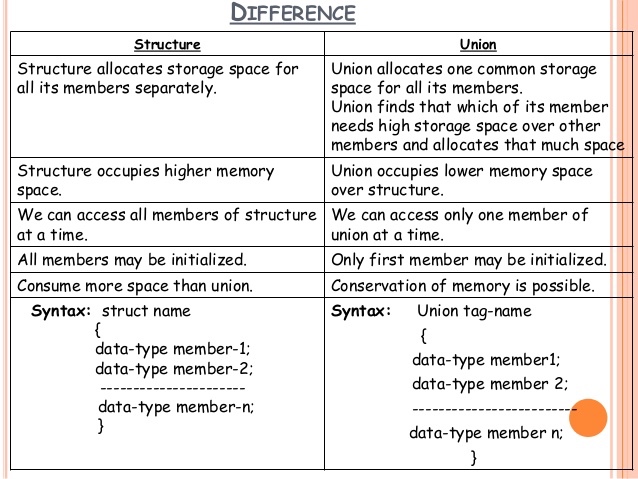C
0 基础¶
struct和union¶
struct中所有变量是"共存"的,可以保存每一个变量;union中各变量是"互斥"的,分配的内存大小取决于所有变量中占据最大内存的那个变量。所以union的内存使用更加精细灵活。
https://splearnings.weebly.com/structure--union-difference-in-c.html


例如你需要表示一个数Value,可以是多个类型ValueType中的一种,其对应的值as可以是bool, 也可以是double。使用union有效的节省了内存。
typedef struct {
ValueType type;
union {
bool boolean;
double number;
} as;
} Value;

位域¶
在结构体内声明位域(Bit fields)的形式如下:
struct {
type [member_name]: width;
}
| 元素 | 描述 |
|---|---|
| type | 只能为int,unsigned int,signed int三种类型 |
| member_name | 位域的名称。 |
| width | 位域中位的数量。宽度必须小于或等于指定类型的位宽度。 |
struct Disk_Register {
unsigned int ready:1 ; // 1 bit field named "ready"
unsigned int error:1 ; // 1 bit field named "error"
unsigned int wr_prot:1 ;
unsigned int dsk_spinning:1 ;
unsigned int command:4 ; // 4 bits field named "command"
unsigned int error_code:8 ;
unsigned int sector_no:16 ;
};
int main( int argc, char* argv[]) {
struct Disk_Register r;
printf( "sizeof(r) = %d\n", sizeof(r) ); // 4 bytes (32 bits)
int* p = (int *) &r; // Access r as in int through pointer p
*p = 0; // Clear all 32 bits in r !
r.error = 1; // Set the error bit (bit #30)
printBits( *p ); // Call the printBits() function
putchar('\n');
r.dsk_spinning = 1; // Set the dsk_spinning bit (bit #28)
printBits( *p ); // Call the printBits() function
putchar('\n');
}
NULL, '\0'¶
NULL是一个宏,在stddef.h中定义为
# define NULL ((void*)0)
NULL表示一个null指针(null pointer)。null指针其实就是字面量0。因此确认一个null指针有以下方法:
if (!pointer)
if (pointer == NULL)
if (pointer == 0)
\0被定义为null字符(null character)或者null terminator,用来表示一个字符串的结束。可以用以下方式确认一个字符串指针是否指向null字符。
if (*string_pointer)
除此之外,\0被视为等同于整数常量0。也就是说以下两种定义是等价的:
char a = 0;
char b = '\0';
null字符在使用字符串初始化字符数组时会自动添加到末尾, 以下定义的sizeof str是6(包含了null字符),strlen(str)是5(不包含)。
// 以下方式等价
char str[] = "hello";
char str[6] = {'h', 'e', 'l', 'l', 'o', '\0'};
1 指针和数组¶
在C语言中,指针和数组非常相似,但是它们并不相同。对数组的引用总是可以写成对指针的引用,但这只是数组的一种极为普通的用法,并非所有情况下都是如此。例如下面的使用方法就是一个典型的错误1:
//file1.c
int mango[100];
// file2.c
extern int *mango;
编译器为每个变量分配一个地址,每个符号的地址在编译时可知。所以,对于数组,可以直接进行操作,并不需要增加指令首先取得具体的地址。相反,对于指针,必须首先在运行时取得它当前值(需要增加一次额外的提取),然后才能对它进行解除引用操作。

对指针进行下标引用时,其实质上是图A和图B访问方式的组合:
- 取得符号表中p的地址,提取存储于此处的指针。
- 把下标所表示的偏移量与指针的值相加,产生一个地址。
- 访问上面这个地址,取得字符。

| 指针 | 数组 |
|---|---|
| 保存数组的地址 | 保存数据 |
| 间接访问数据,首先取得指针的内容,把它作为地址,然后从这个地址提取数据。如果指针有一个下标[I],就把指针的内容加上I作为地址,从中提取数据 | 直接访问数据,a[I]只是简单地以a+I为地址取得数据 |
| 通常用于动态数据结构 | 通常用于存储固定数据且数据类型相同的元素 |
相关的函数为malloc(), free() |
隐式分配和删除 |
| 通常指向匿名数据 | 自身即为数据名 |
char* argv[10];
char buf[20];
argv[0] = buf;
什么时候数组和指针是相同的1:
- 表达式中的数组名就是指针
- 数组下标作为指针的偏移量
- 作为函数参数的数组名等同于指针
int a[10], *p, i = 2;
// 表达式中的数组名
p = a;
// 数组下标作为偏移量
for (int i = 0; i < 10; i++) {
// 以下等价
p[i] = 0;
*(p + i) = 0;
}
// 作为函数参数的数组名
// 以下等价
my_function(int *turnip);
my_function(int turnip[]);
my_function(int turnip[200]);
2 static¶
静态局部变量¶
局部变量使用static关键字修饰后成为静态局部变量。函数内定义的普通局部变量存放在堆栈空间内。而静态局部变量存放在数据段链接中,其生命周期和程序一样长,当定义该变量的函数退出时,该变量的值依然能保持。当该函数下一次进入时,该值依然有效。静态局部变量即使在声明时未赋值,编译器也会把它自动初始化为0。
void fn(void) {
int n = 10; // 普通局部变量
printf("n=%d\n", n);
n++;
}
void fn_static(void) {
static int n = 10; // 静态局部变量
printf("n=%d\n", n);
n++;
}
int main() {
fn(); // 10
fn(); // 10
fn_static(); // 10
fn_static(); // 11
}
静态函数¶
在普通函数的返回类型前加上static关键字,即为静态函数。其特性为:
- 静态函数只能在声明它的文件中可见,其他文件不能引用该函数
- 不同的文件可以使用相同名字的静态函数,互不影响
// main.c
static void fun(void) {
printf("hello from fun.\n");
}
extern void genericFun();
extern void staticFun();
int main() {
fun();
genericFun();
staticFun(); // Undefined symbols _staticFun
}
// file2.c
static void staticFun(void) {
printf("hello from static staticFun.\n");
}
void genericFun(void) {
printf("hello from genericFun.\n");
}
所以只用于本文件的函数全部使用static关键字声明,这是一个良好的编码风格。
3 动态内存分配¶
malloc/free¶
C函数库提供了两个基本函数malloc和free分别用于执行动态内存分配和释放2。
void* malloc(size_t size);
void free(void *pointer);
malloc函数从内存池中提取一块连续的、未初始化的内存,并返回一个指向这块内存的指针。malloc的参数就是需要分配的内存字节数。如果操作系统无法向malloc提供给定的内存,malloc就返回一个NULL指针。malloc并不知道所请求的内存是存储何种数据(整数、浮点、结构等),所以它返回一个void *类型的指针。
free函数的参数要么是NULL(没有任何效果),要么是先前从malloc, calloc或realloc返回的值。
calloc/realloc¶
void* calloc(size_t num_elements, size_t element_size);
void* realloc(void* ptr, size_t new_size);
calloc和malloc之间的主要区别是calloc在返回指向内存的指针之前把它初始化为0.
realloc函数用于修改一个原先已经分配的内存块的大小。
- 如果它用于扩大一个内存块,那么这块内存原先的内容依然保留,新增加的内存添加到原先内存块的后面,新内存并未以任何方式进行初始化。
- 如果内存空间不够,将分配另一块正确大小的内存,并把原来那块内存的内容复制到新的块上,并返回新的指向新内存的指针。
- 如果它用于缩小一个内存块,该内存块尾部的部分内存便被拿掉,剩余部分内存的原先内容依然保留。
